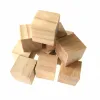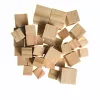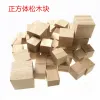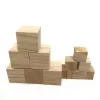Unleash Your Creativity with 1 cm Wood Cubes: The Perfect Tool for Art, Education, and Play
Wood cubes aren’t just for building structures anymore – they can also be an excellent tool for teaching children important skills. From math and geometry to spatial reasoning, these versatile cubes can be used in a variety of educational settings or activities to reinforce learning. For example, children can build towers and count the number of cubes, or use them to create 3D shapes and understand geometry principles. Additionally, unstructured play with these cubes can encourage imagination and creativity, which is crucial for children’s development. By providing opportunities for open-ended play, children can learn to solve problems, think critically, and develop social skills. So next time you’re looking for an engaging and educational toy for your child, consider investing in some wood cubes!






Education
Mathematics is one of the foundational subjects taught in schools, and wooden cubes make it easy to introduce numerical concepts to young learners. For instance, cubes can be used to teach basic arithmetic operations such as addition, subtraction, multiplication, and division. Teachers can also use them to teach fractions by dividing or grouping the cubes appropriately. Children can use the cubes to solve equations by arranging them in various patterns or creating structures that demonstrate mathematical concepts practically.
Geometry is another subject that can be taught using wooden cubes. The blocks can be used to introduce basic shapes such as squares, rectangles, triangles, and circles. As students progress, they can use the cubes to create more complex forms such as prisms, pyramids, and spheres. By manipulating the blocks, students can learn about angles, lines, planes, and dimensions.
Spatial reasoning is a crucial skill that helps individuals understand and relate to the world around them. Wooden cubes can be used to develop this skill by engaging students in activities that require them to visualize and manipulate objects in 3D space. Teachers can ask students to create towers, bridges, and other structures using the cubes. They can also challenge students to recreate shapes or patterns from memory, without looking at visual aids.
To reinforce learning, teachers can provide students with different variations of activities to keep them engaged and interested. For example, in a math class, teachers can have students race against each other to solve equations using the cubes. In a geometry class, students can work together to create complex structures using the blocks. To encourage spatial reasoning, teachers can give students puzzles to solve and challenges to overcome that involve the cubes.
Play
Open-ended play is exactly what it sounds like – it’s play that has no set rules or objectives. Instead, children can use their imagination and creativity to come up with their own scenarios and games. Wood cubes are perfect for this type of play because they can be stacked, sorted, counted, and arranged in countless ways. They can be used to build structures, create artwork, or even as props in imaginary worlds.
One of the benefits of open-ended play is that it allows children to take the lead and make their own choices. This can boost their self-confidence and decision-making skills. It also encourages them to think critically and problem-solve, as they figure out how to make the blocks balance or fit together in a certain way.
Another important aspect of open-ended play is that it fosters creativity. When children are given the freedom to play without constraints, they can let their imaginations run wild. They might invent new games or stories, or come up with unique designs and patterns using the blocks.
But why is unstructured play so important for children’s development? For starters, it helps them develop social skills. When children play together without a set game or activity, they have to negotiate and communicate with each other to decide what to do. This can teach them how to work collaboratively and resolve conflicts peacefully.
Unstructured play also promotes physical development. When children are building, stacking, and manipulating the blocks, they’re developing their hand-eye coordination and fine motor skills. They’re also learning about spatial relationships and cause-and-effect as they experiment with different block configurations.
Finally, open-ended play can have positive effects on children’s emotional well-being. When they’re engaged in play that they enjoy and that allows them to express themselves, they’re more likely to feel happy and fulfilled. This can boost their overall mood and reduce stress and anxiety.
In conclusion, may seem like a simple toy, but they have the potential to offer children hours of open-ended play that can support their development in numerous ways. By encouraging unstructured play, we can give our little ones the tools they need to explore their creativity, build social skills, and develop physically and emotionally. So next time you’re looking for something to entertain your child, consider reaching for those trusty wooden blocks.
FAQ
Q1. What are the dimensions and materials of the 1 cm wood cubes?
The 1 cm wood cubes are precisely cut into perfect 1 cm cubes, made from high-quality and durable natural wood. Each cube measures 1 cm x 1 cm x 1 cm, providing a small and versatile building block for various creative projects.
Q2. How can I use the 1 cm wood cubes for art and creativity?
The 1 cm wood cubes are ideal for unleashing your creativity in various art projects. You can use them to create intricate patterns, mosaic designs, and 3D sculptures. Their small size allows for detailed and precise artwork, making them perfect for jewelry making, miniature model building, and mixed media art.
Q3. How can the 1 cm wood cubes be utilized for educational purposes?
These cubes are a valuable tool for educational activities and learning exercises. They can be used for teaching math concepts such as counting, sorting, and geometry. Additionally, they can enhance spatial awareness, fine motor skills, and hand-eye coordination in young learners. The cubes can also be painted or labeled with numbers, letters, or symbols for language and literacy activities.
Q4. What are the benefits of using the 1 cm wood cubes for play and creative exploration?
The 1 cm wood cubes provide endless opportunities for open-ended play and imaginative exploration. Children can use them to build structures, create patterns, and engage in sensory play. The cubes promote problem-solving, critical thinking, and collaboration in a fun and engaging way. They also encourage imaginative storytelling and role-playing, fostering holistic development in children.
In conclusion, the 1 cm wood cubes are a versatile tool for unleashing creativity in art, education, and play. Their small size, durable material, and limitless potential make them an essential resource for artists, educators, and parents alike. Whether used for creating intricate artwork, facilitating learning activities, or promoting imaginative play, these wood cubes are the perfect tool for sparking creativity in people of all ages.



